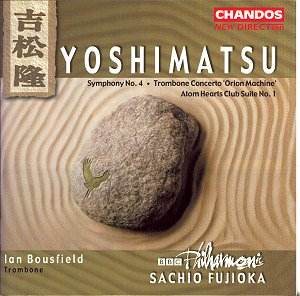This is the fifth disc that Chandos have devoted to
the music of Takashi Yoshimatsu and in dedicating his Symphony No. 4
to Ralph Couzens, Chandos’s producer, the composer acknowledges in his
booklet note the motivation he has drawn from the advocacy of both Couzens
and his Japanese compatriot, the young conductor Sachio Fujioka, now
resident in the United Kingdom following his stint as Assistant Conductor
of the BBC Philharmonic in the mid 1990’s.
Yoshimatsu describes his Fourth Symphony as
a kind of "pastoral toy symphony", combining a vision of children
at play in the new millennium with images of nature, in particular the
verdancy of spring. Cast in four movements the work is immediately attractive,
unashamedly tuneful and generally light hearted, this despite the fact
that the composer originally had in mind a symphony with "a dark
and heavy adagio". The opening movement transports us through a
variety of shifting tempos and metres, commencing with a gently dancing
woodwind figure, which returns frequently and subsequently undergoes
development in a variety of ways. A contrasting, heartfelt string melody
which would not sound out of place in the film score of Out Of Africa
appears at 3’00", returning in the closing moments of the symphony,
whilst the music also moves through several more rhythmically driving
sections, characteristically influenced by the beat of rock and popular
music. The scherzo, really a distorted waltz, has an opening melody
that sounds curiously like a piece of English light music, gradually
becoming interwoven with a diverse collection of waltz tunes by numerous
other composers, amongst them Berlioz, Mahler and Beethoven. The third
movement, an Adagietto, features a long, unfolding melody for
the strings, which draws on the string figure from the first movement
and introduces a music box like figure on piano part way through, whilst
the Finale, progressing in rhythmic urgency from Allegro molto
to Presto, is based on a variant of the opening dancing woodwind
theme from the first movement.
Written for the principal trombonist of the Japan Philharmonic
Symphony Orchestra, the Trombone Concerto ‘Orion Machine’ takes
its subtitle, as well as its five-movement form and the titles of each
movement, Betelgeuse, Bellatrix, Trapezium, Saiph
and Rigel from the structure of the stars within the constellation
of Orion. Yoshimatsu complements the trombone with a "quasi-solo
section" of piano, harp and percussion, placed centrally and surrounded
by the other instruments of the orchestra. An impressive understanding
of the instrument and its character, testing the soloist’s technique
to the limits with some extraordinary pyrotechnics yet managing to avoid
sounding contrived, marks the work. After a suitably atmospheric opening
the soloist spins a long largo melody that fully exploits the lyrical
qualities of the instrument with a slightly bluesy feel at times before
the music fractures and takes us straight into Bellatrix. Marked
Presto, this is Yoshimatsu back in rock style, this time a little
more astringent and jazz influenced. Bousfield despatches the demands
of the part with true flair and élan, athletically flying up
and down the register of the instrument with consummate ease. Trapezium
slows things down once again, a dirge with a broken waltz at its centre
that sounds not unlike the waltz from the symphony of seven years later.
Saiph is an extended cadenza, the second half of which leaves
the players free to improvise. An opportunity here for the soloist to
show off his extended technique with some truly amazing sounds and effects
(listen to the unaccompanied passage from around 2’10", it’s astonishing
stuff!). Finally, Rigel brings the work to a glowing conclusion,
"a resplendent consonant rainbow", as the composer aptly puts
it, the soloist returning to the lyrical style of the opening movement
as the music gradually subsides to a peaceful close.
Anyone who has any knowledge of 1970’s rock music may
well detect a clue in the title of Atom Hearts Club Suite No. 1
as to one, if not two, of its influences. The Beatles’ Sgt. Pepper’s
Lonely Hearts Club Band is perhaps the most obvious although
the composer cites Pink Floyd’s Atom Heart Mother, Emerson, Lake
and Palmer’s Tarkus and Fragile by Yes as the others.
Add to this the comic-book hero Mighty Atom and what we have is a four
movement suite for string orchestra that is strongly rock based in its
rhythmic impetus with irregular, prog-rock style metres in the opening
Allegro molto and boogie-woogie in the Finale with an
amusing tongue in cheek conclusion. Some may dismiss it as "light
music" but whatever your viewpoint, it is undeniably fun, toe-
tapping stuff and there is little wrong with that!
Much of this music is delightful, particularly the
Symphony where Yoshimatsu wears his heart unselfconsciously on
his sleeve. Sadly however, I suspect that in the broader musical scheme
of things its "popular" stylistic language is likely to lend
it little longevity of appeal. The BBC Philharmonic play beautifully
for Sachio Fujioka and Ian Bousfield, now principal trombone with the
Vienna Philharmonic after a number of years with the LSO, is a very
fine soloist indeed in the concerto. The recording too is exceptionally
transparent, capturing the detail with an admirable natural clarity.
Christopher Thomas
See also
TAKASHI
YOSHIMATSU (1953-) Saxophone Concerto Cyber-Bird (1993) Symphony
No. 3 (1995) Nobuya Sugawa (saxophone) BBCPO/Sachio Fujioka CHANDOS
New Direction CHAN 9737 [68.15]


